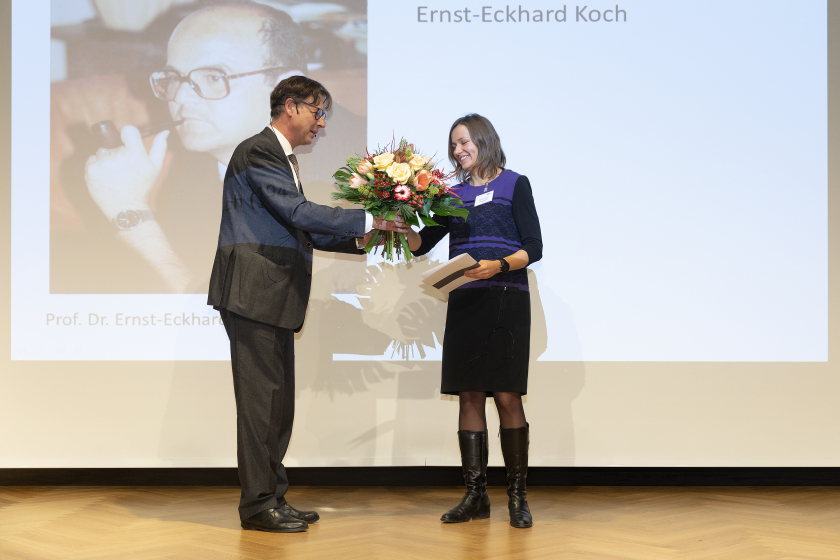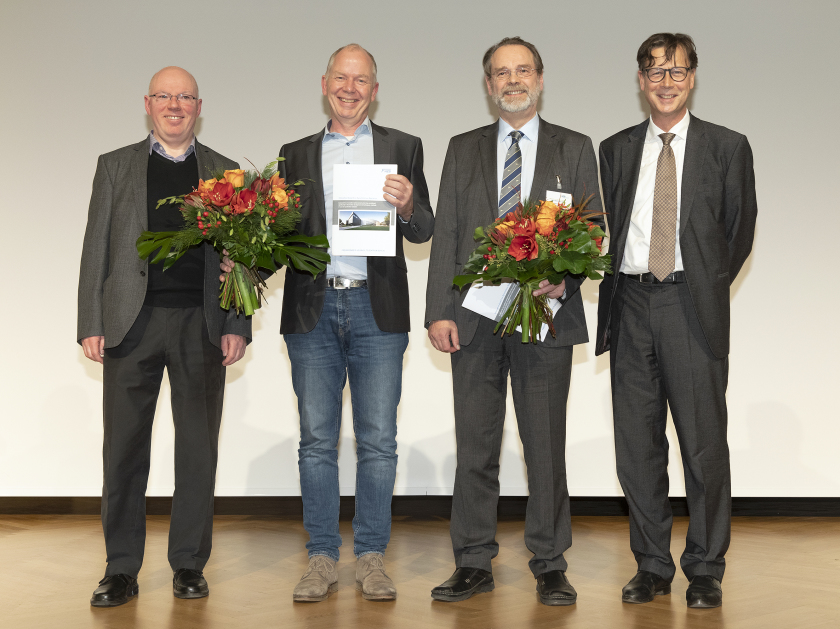Ernst Eckhard Koch Prize and Synchrotron Radiation Innovation Award

The Ernst Eckhard Koch Prize went to Dr. Victoriia Saveleva (right) for her work on catalysts. © M. Setzpfandt/HZB

Laudator Prof. Gerd Schneider, award winners Dr. Christian David and Prof. Alexei Erko and Prof. Mathias Richter, Friends of HZB, (From left to right). © M. Setzpfandt/HZB
On December 6, 2018, the Association of Friends of Helmholtz-Zentrum Berlin awarded the Ernst Eckhard Koch Prize for an outstanding doctoral thesis in the field of research with synchrotron radiation at the HZB or at DESY as well as the European Innovation-Award on Synchrotron Radiation. The award ceremonies took place during the 10th User Meeting at the HZB.
The decisions between excellent proposals have not been easy for the two selection committees, Prof. Mathias Richter, chairman of the “Friends of HZB” pointed out.
The Ernst Eckhard Koch Prize went to Dr. Victoriia Saveleva for her doctorate at the University of Strasbourg on in-situ investigations of electrochemical processes using photoemission spectroscopy. Her experiments at BESSY II focused on reactions on catalyst surfaces of ruthenium and iridium during the electrolytic decomposition of water. Saveleva is now a postdoctoral researcher at the Paul Scherrer Institute in Switzerland.
The Innovation Award on Synchrotron Radiation 2018 went to Dr. Christian David, also from the Paul Scherrer Institute, and to Prof. Alexei Erko, who recently moved from the HZB to the Institute for Applied Photonics (IAP) in Berlin-Adlershof. The two physicists were honored for their innovative contributions to the application of diffractive X-ray optics, which enable complex X-ray experiments with high resolution. The laudation was held by Prof. Gerd Schneider from the HZB. This time it was not the "ring makers" who were honoured for developing the accelerators, but those who had cut the "diamonds for the ring", Schneider explained pictorially. The Synchrotron Radiation Innovation Award is sponsored by SPECS GmbH and BESTEC GmbH.
arö
-
A new way to control the magnetic properties of rare earth elements
The special properties of rare earth magnetic materials are due to the electrons in the 4f shell. Until now, the magnetic properties of 4f electrons were considered almost impossible to control. Now, a team from HZB, Freie Universität Berlin and other institutions has shown for the first time that laser pulses can influence 4f electrons- and thus change their magnetic properties. The discovery, which was made through experiments at EuXFEL and FLASH, opens up a new way to data storage with rare earth elements.
-
HZB magazine lichtblick - the new issue is out!
In his search for the perfect catalyst, HZB researcher Robert Seidel is now getting a tailwind – thanks to a ERC Consolidator Grant. In the cover story, we explain why the X-ray source BESSY II plays an important role for his research.
-
BESSY II shows how solid-state batteries degrade
Solid-state batteries have several advantages: they can store more energy and are safer than batteries with liquid electrolytes. However, they do not last as long and their capacity decreases with each charge cycle. But it doesn't have to stay that way: Researchers are already on the trail of the causes. In the journal ACS Energy Letters, a team from HZB and Justus-Liebig-Universität, Giessen, presents a new method for precisely monitoring electrochemical reactions during the operation of a solid-state battery using photoelectron spectroscopy at BESSY II. The results help to improve battery materials and design.
